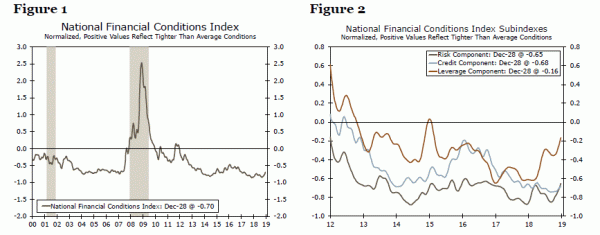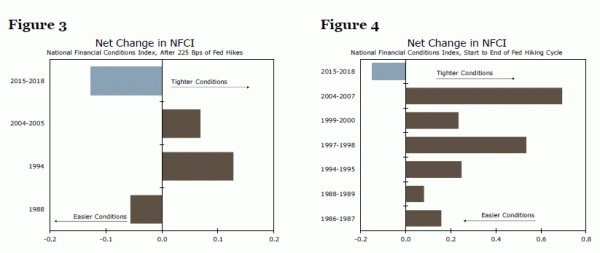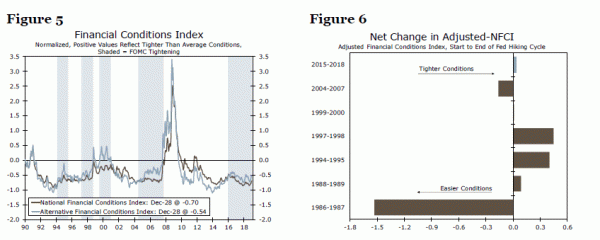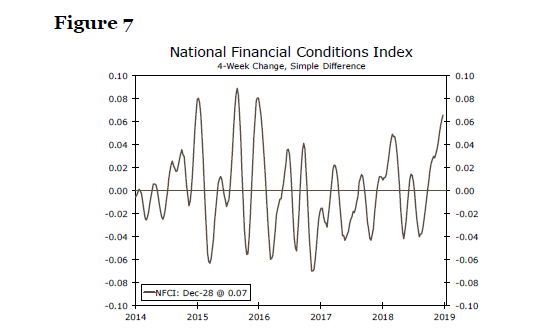Executive Summary
Financial conditions have tightened in recent months, prompting speculation that the Federal Open Market Committee (FOMC) may need to alter its current expectation of raising the fed funds rate two more times this year. The Chicago Fed’s National Financial Conditions Index (NFCI) increased 13 bps between the FOMC’s September and December meetings—the largest increase between FOMC rate hikes since 2000—implying that overall financial conditions have tightened. Yet financial conditions are easier today than when the FOMC began raising rates in December 2015. So is the FOMC likely to look through the recent moves?
It is not unusual to see financial conditions ease while the FOMC is tightening policy—both are responding to the stronger economy. Controlling for the macroeconomic environment, however, shows that financial conditions have tightened more than the NFCI implies, and are tighter in total than when the FOMC first raised rates in late 2015. While financial conditions do not seem overly restrictive at present, the FOMC may decide that a wait-and-see period may be appropriate given the speed of recent tightening in financial conditions and current expectations for growth to slow toward its longer-run trend. Our most recent forecast, which was compiled in early December, looks for the Fed to hike rates 25 bps in March and another 25 bps in September. But we readily acknowledge that the risks are skewed to a longer pause in the first half of the year than we thought just a month ago due to the recent tightening in financial conditions.
Financial Conditions Have Tightened
Financial markets deteriorated sharply at the end of 2018. The S&P 500 fell more than 10% in the fourth quarter, while the yield on the 10-year Treasury security slid about 30 bps as investors flocked to safer assets. Given the forward-looking nature of markets, the tumult raised concerns about growth in the new year and was even seen as a reason the FOMC might hold off on its widely telegraphed rate hike in December. Chairman Powell stated numerous times in his post-meeting press conference that the Committee was not looking solely at financial markets, but broad financial conditions. So how have financial conditions—not just markets—evolved recently, and what does it mean for economic growth and the future path of FOMC policy?
For a wide-ranging view of financial conditions, we turn to the Chicago Fed’s National Financial Conditions Index (NFCI). The index includes 105 variables, capturing leverage, risk and credit conditions. Since the index is constructed to average zero over time (with a standard deviation of one), negative readings indicate historically loose financial conditions, while positive readings indicate historically tight conditions. Therefore, higher values of the index are indicative of tighter financial conditions.
The NFCI rose 14 bps over the fourth quarter of 2018 (Figure 1). The move was the largest quarterly increase since the start of 2016—a point at which the FOMC hit pause on rate hikes. Specifically, risk-related measures, like the VIX index and TED spread, have risen over the past few months. At the same time, indications of leverage, like weakening corporate debt issuance, have pointed to more restrictive financial conditions (Figure 2). Credit conditions, which reflect the willingness to borrow and lend at prevailing prices, have been little changed. But the overall NFCI generally remains at a low level, indicating that general financial conditions are not overly restrictive at present.
Financial Conditions: The Transmission Channel between FOMC Policy and the Real Economy
Financial conditions per se are not an objective for the FOMC, but they are taken into account due to their indirect effects on the Fed’s two policy goals: “price stability” and “maximum employment.” The committee’s aim in tightening policy is to prevent the economy from overheating to the point that it risks significantly overshooting its inflation target, which it defines as PCE inflation of 2%. However, the FOMC’s primary policy tools, the fed funds rate and the balance sheet, have little direct effect on the Fed’s two policy objectives.
Instead, the FOMC’s tools affect the economy by influencing other interest rates and risk taking. In that way, financial conditions capture the transmission of FOMC policy to the real economy. Businesses and households will modify investment and saving plans depending on the relative ease or tightness of financial conditions. Tighter conditions, reflecting the availability and cost of credit, may reduce the ability and/or willingness to take on debt, which, all else equal, could weigh on growth in investment and consumption and thereby on the overall rate of real GDP growth. In contrast, easier conditions could stoke up growth in consumption and investment.
Behind the Starting Line after Three Years of FOMC Tightening
Given that financial conditions are influenced by FOMC policy, it is not unexpected to see broader financial conditions tighten as the Fed normalizes policy. In other words, tighter financial conditions are an anticipated byproduct of FOMC rate hikes. But monetary policy decisions and broad financial conditions do not always move in tandem. Despite the FOMC raising its target range for the fed funds rate 225 bps since late 2015, financial conditions as measured by the NFCI have eased on net over the period (Figure 3). The easing has primarily come in terms of credit, with, for example, corporate bond spreads narrower and bank lending standards looser. The overall easing in financial conditions since late 2015 stands in contrast to the previous two tightening cycles in which the FOMC raised rates by the same amount. As noted previously, general financial conditions do not appear to be overly restrictive at present.
With financial conditions still easy relative to when the Fed first began to normalize policy, does that mean there is more tightening in store? In each of the previous six rate-hiking cycles, the FOMC did not stop until financial conditions had tightened on net (Figure 4). This historical record suggests that the FOMC may very well have a few more rate hikes to go in this cycle, at least at first glance.
Does the FOMC Need to See Financial Conditions Tighten Further?
The traditional NFCI does not take into account underlying economic conditions. All else equal, it makes sense for investors to take on more risk, for households to take on more debt and for lenders to ease standards in an improving economic environment. As a result, financial conditions and economic conditions are often closely correlated. Therefore, it is not unusual to see financial conditions ease, at least for a time being, at the same time the FOMC is raising rates—both are responding to a stronger economy.
To isolate financial conditions only, the Chicago Fed also calculates an Adjusted National Financial Conditions Index (ANFCI).1 The ANFCI controls for the macroeconomic environment, and thus it is more telling in regard to how underlying financial conditions have evolved. By this measure, financial conditions have tightened more in recent months than implied by the NFCI alone (Figure 5). Specifically, the ANFCI has increased about 20 bps since late September, which is about twice as much as the increase in the NCFI. Although the ANFCI remains low in a historic context, the rise in the index implies that financial conditions are a bit tighter in total than when the Fed first began raising rates in late 2015 (Figure 6).
The degree to which financial conditions have tightened over a rate-hike cycle helps quantify how far—or short—the FOMC has come. Yet there is no set amount by which financial conditions need to tighten, or a threshold to cross, before the FOMC stops raising rates. If the economy is showing few signs of overheating, looser financial conditions relative to the start of a tightening cycle are not necessarily a problem. The same can be said for an economy where growth is slowing back toward its longer-run trend, as is the case today.
How financial conditions impact the stability of the overall financial system may, however, be of concern. If a prolonged period of loose financial conditions stokes instability via greater risk taking, more leverage and questionable credit, then those factors may affect policymaking. That said, the primary means of addressing financial instability are likely to be targeted regulatory (macro-prudential) policies by the Federal Reserve and other federal banking agencies rather than the blunter tool of changes in interest rates by the FOMC. At present, the Fed generally does not seem to be unduly concerned with financial stability. The Federal Reserve Board’s inaugural Financial Stability Report released in November found that while valuations are elevated, private sector credit risks are moderate and leverage and funding risks are low.2
Moreover, the cumulative amount of tightening in financial conditions may not be as much of an issue as the speed. Over the past month, the financial conditions indices rose faster than at any time since the start of 2016 (Figure 7). Given that it takes time for financial conditions to effect the real economy, the FOMC could perceivably hold off on subsequent rate hikes in the near term as it waits to see how financial conditions have affected growth prospects
Conclusion: The FOMC Might Revisit the Pause Button
The last time financial conditions tightened as sharply as this past December was at the start of 2016. Back then, the FOMC had just raised the fed funds target rate for the first time since the crisis. However, signs of slower growth in China caused volatility in financial markets to spike and overall financial conditions tightened. Following its initial rate hike in December 2015, the FOMC subsequently remained on hold until December 2016.
Our most recent forecast, which was compiled in early December, looks for two 25 bps rate hikes in 2019, first in March and again in September. But we readily acknowledge that the risks are skewed to a longer pause in the first half of the year than we thought just a month ago. Overall financial conditions do not appear to be overly restrictive at present, but they clearly have tightened in recent weeks. Consequently, the FOMC may decide that a period of wait-and-see is again appropriate, especially with the fed funds target rate already close to many committee members’ estimates of “neutral” and with inflation showing few signs of significantly exceeding the Fed’s target of 2%. We will be watching incoming data and making changes to our Fed call, as appropriate
















